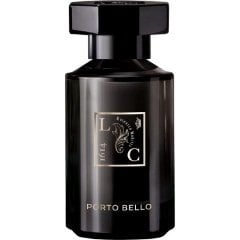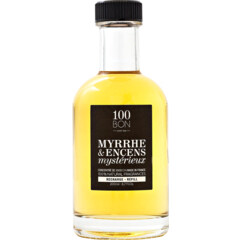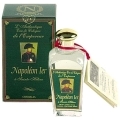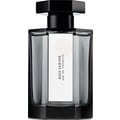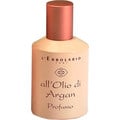
Pimm
Reviews
Leathery, resinous, spicy, dark green, orange-y, smoky, mildly sweet
... without indeed smelling of leather, particular resins, spices, herbs or woods, not clearly of cognac or vanilla and only briefly of orange. All the same, the whole of PB is very recognizable and memorable to me. I can picture a sort of fantasy forest created by cool herbal notes and warm moss, and purple streaks of clouds at sunset suggested by creamy, balsamic and boozy notes. Lately – having sprayed the fragrance occasionally over the course of a year, I must say that the first one or two hours feel decidedly too sweet to me, as if a metallic energy drink had been added to the mix – or had been spilled over those imaginary watercolor landscapes. The likeliest culprit would seem Ambroxide, which I apparently perceive as sugary and sterile when highly dosed (in particular in “Molecule 02”). I suspect that I'm becoming more bothered by this, even in fragrances like PB that have other prominent sweet notes. (Though I'm really not confident that PB does contain a lot of Ambroxide.) My perception of the dry-down hasn't changed much: moderately sweet, orange-chocolate-y creamy and a little spicy, not too overtly gourmand. Well, with or without the sugar water, I've always found the fragrance too pleasing, sentimental and warm for me to wear. For that reason, I also haven't paid great attention to its projection and longevity; seems decent in both respects.
Regarding olfactory notes, apart from the “cognac accord,” I don't find the pyramid provided by the Couvent terribly descriptive. Neither the sweet orange nor the frankincense are prominent by my reckoning. (Though I imagine that the incense plays an important role, perhaps indeed as a part of that cognac accord.) I guess the brand is following a pattern of two advertised natural materials per fragrance. I'm not sure what to make of the rarely used davana note. That plant is of the Artemisia genus, so I'd expect something herbal. An older pyramid appears to be preserved in an article [1] by Bella van der Weerd. Petitgrain and benzoin are included in that one. Petitgrain figures for me – though it's not overt –, benzoin perhaps if the (supposedly warmer, spicier) Sumatran kind is meant. That one could perhaps hide between labdanum and (synthetic) oakmoss, both of which I find quite apparent. I'm also suspecting a medium dose of patchouli among the green and chocolate-y notes.
Alternatives: Margiela's “Jazz Club” immediately reminded me of PB, the sweet notes (apart from the supposed Ambroxide), warm resins and moss are strikingly similar. JC has a different aesthetic, however, with concrete impressions of cigars, leather and rum. It's also much spicier, less green and more animalic than PB. “Side Effect” by Initio becomes somewhat similar to PB only late in its development: creamy, slightly sweet and smoky; (fruit) brandy, warm backdrop. I've seen Amouage fragrances mentioned, broadly, as being in a similar vein as PB. I'm still exploring that avenue, but it seems clear enough that those tend to be more oriental, more unusual and pricier. (Though the Couvent has been increasing its prices over the last few years and PB is now squarely mid-range.)
[1] B. van der Weerd: “A New Line from Le Couvent des Minimes: Parfums Remarquables,” 2019, user account required:
https://www.fragrantica.com/news/A-New-Line-from-Le-Couvent-des-Minimes-Parfums-Remarquables-11872.html
Regarding olfactory notes, apart from the “cognac accord,” I don't find the pyramid provided by the Couvent terribly descriptive. Neither the sweet orange nor the frankincense are prominent by my reckoning. (Though I imagine that the incense plays an important role, perhaps indeed as a part of that cognac accord.) I guess the brand is following a pattern of two advertised natural materials per fragrance. I'm not sure what to make of the rarely used davana note. That plant is of the Artemisia genus, so I'd expect something herbal. An older pyramid appears to be preserved in an article [1] by Bella van der Weerd. Petitgrain and benzoin are included in that one. Petitgrain figures for me – though it's not overt –, benzoin perhaps if the (supposedly warmer, spicier) Sumatran kind is meant. That one could perhaps hide between labdanum and (synthetic) oakmoss, both of which I find quite apparent. I'm also suspecting a medium dose of patchouli among the green and chocolate-y notes.
Alternatives: Margiela's “Jazz Club” immediately reminded me of PB, the sweet notes (apart from the supposed Ambroxide), warm resins and moss are strikingly similar. JC has a different aesthetic, however, with concrete impressions of cigars, leather and rum. It's also much spicier, less green and more animalic than PB. “Side Effect” by Initio becomes somewhat similar to PB only late in its development: creamy, slightly sweet and smoky; (fruit) brandy, warm backdrop. I've seen Amouage fragrances mentioned, broadly, as being in a similar vein as PB. I'm still exploring that avenue, but it seems clear enough that those tend to be more oriental, more unusual and pricier. (Though the Couvent has been increasing its prices over the last few years and PB is now squarely mid-range.)
[1] B. van der Weerd: “A New Line from Le Couvent des Minimes: Parfums Remarquables,” 2019, user account required:
https://www.fragrantica.com/news/A-New-Line-from-Le-Couvent-des-Minimes-Parfums-Remarquables-11872.html
Incense-y gingerbread
... that is, a lot of cinnamon, especially in the top note, an extra dose of coumarin; honeyed, a little buttery, somewhat dough-like, perhaps through some heliotropin – though not nearly as powdery as the remotely similar “Pi” by Givenchy. A fair amount of patchouli and a labdanum amber note also seem apparent to me. I know myrrh essential oil as a dark, mushroom-like licorice scent that brightens over time. This may well add to the vanillic dry-down of M&E, and, from the start, I do feel reminded specifically of German lebkuchen, which is frequently flavored with anise. Olibanum, similarly, is not all that prominent. Some days, I do smell its churchy, wafty bitterness clearly for a while. I suppose the resins add an important background of dark and sourish notes that save the fragrance from smelling stuffy or unrefined.
Having seen six slightly different versions of the olfactory pyramid (the packaging of my own bottle, archived versions of the 100BON web page, official-looking info sheets in sales listings), the notes that they all agree on are patchouli, myrrh, incense, tonka bean and a citrus top note (bergamot/ lemon/ various). I don't even notice that citrus note on my skin unless I spray twice. Most versions of the pyramid also include opoponax, which may help explain why this is a rather sweet myrrh fragrance. The papyrus note is not always present, sometimes notes like “amber wood” or “cashmere oud” seem to take its place. I'm suspecting that this refers to a woody-earthy accord involving cypriol. I think I'm familiar with that from oud fragrances and that it adds some dry bitterness here especially in the top note. Occasionally included top notes of “fraîcheur” and “sous-bois” (undergrowth) don't ring a bell for me.
I find M&E quite sweet, closer to an amber gourmand than to an exploration of (frank-)incense and (common) myrrh. In that latter vein, I appreciate how Dior's “Bois d'argent” brings out the subtle beauty of those resins. M&E is (very) mildly sickening to me, perhaps not so much because of the overall sweetness, which is balanced, to an extent, by bitterness, but rather because I seem to have trouble with highly dosed cinnamon or with cypriol or both.
The projection seems rather strong in the beginning and, at a close distance, the intensity rather too high; after an hour, it's perhaps already rather too discreet. I find that some projection – and the fragrance's essential character – is retained for some 8 hours. Whether M&E can be considered a cheapie would depend on local deals; the current 100BON asking price isn't far below mid-tier in my book.
Lastly, a note about the advertised “100% ingredients of natural origin”: My guess is – though I don't think it says so on the web page – that this refers to ISO 16128 or a similar standard for naturalness, and that a “natural origin” only rules out most petrochemicals. Which might avoid possible health risks from e.g. phthalates, but I certainly don't take that 100% figure to mean that unusually high amounts of natural fragrance materials are used or even that purely synthetic materials like Iso E Super are off-limits.
Having seen six slightly different versions of the olfactory pyramid (the packaging of my own bottle, archived versions of the 100BON web page, official-looking info sheets in sales listings), the notes that they all agree on are patchouli, myrrh, incense, tonka bean and a citrus top note (bergamot/ lemon/ various). I don't even notice that citrus note on my skin unless I spray twice. Most versions of the pyramid also include opoponax, which may help explain why this is a rather sweet myrrh fragrance. The papyrus note is not always present, sometimes notes like “amber wood” or “cashmere oud” seem to take its place. I'm suspecting that this refers to a woody-earthy accord involving cypriol. I think I'm familiar with that from oud fragrances and that it adds some dry bitterness here especially in the top note. Occasionally included top notes of “fraîcheur” and “sous-bois” (undergrowth) don't ring a bell for me.
I find M&E quite sweet, closer to an amber gourmand than to an exploration of (frank-)incense and (common) myrrh. In that latter vein, I appreciate how Dior's “Bois d'argent” brings out the subtle beauty of those resins. M&E is (very) mildly sickening to me, perhaps not so much because of the overall sweetness, which is balanced, to an extent, by bitterness, but rather because I seem to have trouble with highly dosed cinnamon or with cypriol or both.
The projection seems rather strong in the beginning and, at a close distance, the intensity rather too high; after an hour, it's perhaps already rather too discreet. I find that some projection – and the fragrance's essential character – is retained for some 8 hours. Whether M&E can be considered a cheapie would depend on local deals; the current 100BON asking price isn't far below mid-tier in my book.
Lastly, a note about the advertised “100% ingredients of natural origin”: My guess is – though I don't think it says so on the web page – that this refers to ISO 16128 or a similar standard for naturalness, and that a “natural origin” only rules out most petrochemicals. Which might avoid possible health risks from e.g. phthalates, but I certainly don't take that 100% figure to mean that unusually high amounts of natural fragrance materials are used or even that purely synthetic materials like Iso E Super are off-limits.

 Pimm
Pimm